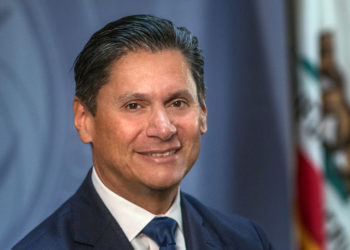
As we head toward the conclusion of another academic year, it’s important to take... Read More about Listening Tour Offers Opportunity to Discuss Vision for Success

The future is building.
From skills and opportunities, to industry partnerships, to the very educational infrastructure that will found California’s future, the key to success in workforce development is in what’s being built.
So, when it came time to appoint a new head of workforce and economic development projects, the California Community Colleges Chancellor’s Office chose not only a leader, but a builder.
In January, the Chancellor’s Office announced former Long Beach City College executive Sheneui Weber would become the new vice chancellor of Workforce and Economic Development, taking over the Strong Workforce initiative. With a versatile resumé in workforce training and a history of forging connections with entrepreneurs and industry, Weber hopes to bring an inclusive approach to meeting the goals of the Vision for Success.
“The California Community Colleges are a big part of the solution for those struggling to make a better living,” said Weber, who served a variety of leadership roles in her 18 years at LBCC, including chief operating officer for Advancement and Economic Development. “We must collaborate across programs, break down the silos, leverage resources, and find ways to weave the workforce and academic programs together, and the funding streams.”
Weber joins the Chancellor’s Office executive staff at a brisk time for adult education and workforce readiness issues, with a projected 2.1 million-worker “middle-skills gap” already beginning to take its toll on the state economy. This practical demand, combined with California’s commitment to closing regional achievement and equity gaps, have boosted not only the funding for workforce development initiatives, but the stakes as well. Hence, the timeliness of Weber’s hire.
“Preparing Californians for the workforce of the future and ensuring that our students can thrive in the new economy are key to the success of our state and nation,” said California Community Colleges Chancellor Eloy Oakley. “Sheneui brings a depth and breadth of experiences in workforce training, entrepreneurship, business development and an understanding of the changes that AI and automation are bringing to the workforce.”
For Weber, closing gaps in adult education outcomes, and in turn, broader gaps in achievement and economic mobility, starts with collaboration: between the colleges, the legislature and community, and most critically, business and industry.
“Addressing the workforce issue cannot be done without partnerships with industry, which I learned very early on in my career,” said Weber. “The whole point of education and training students is to get people into meaningful career paths, sometimes we have to start with just getting them into a job first.”
With direct influence on five of the six Vision for Success goals, workforce and economic development is among the most important aspects of the system’s overall challenge. Thankfully, says Weber, the new governor’s commitment to many of the same objectives surrounding higher education and socioeconomic mobility will make things easier.
“Gov. Newsom’s 2019-20 budget is an investment in ‘making the California Dream more accessible and affordable,’ which is central to the work that the California Community Colleges do,” said Weber, in reference to the College Promise and workforce training provisions in the January 18 budget update. “We appreciate Gov. Newsom’s commitment in expanding educational opportunities to all and look forward to working with him.”
Weber’s plan for fulfilling the Vision’s goals starts with a hard look at the data, and continues with an efficiency-focused strategy that prioritizes investments much like a small business would. For the founder of three successful, partnership-driven workforce programs at LBCC, it only makes sense to look to the world of business to solve what is essentially a supply-and-demand problem.
“Having worked with many entrepreneurs, I have learned that entrepreneurs love to solve problems. For many, the sole reason for starting their business is to solve a particular problem that met a need,” said Weber, who launched the Innovation Fund SoCal, the Goldman Sachs 10,000 Small Businesses program and the college’s first Entrepreneur-in-Residence program while at LBCC. “Education can benefit greatly by engaging and harnessing the creativity, energy, and entrepreneurial thinking to solve many of our workforce challenges.”
Despite her depth of experience, Weber remains focused, motivated and even humbled by the tremendous challenge facing California’s 115 community colleges as they settle into their essential roles in the new economy.
“The Vision for Success essentially calls upon all of us in the system to adapt and change how all students are being served, with the Chancellor’s office leading the way,” said Weber. “I’m looking forward to working with my colleagues and the colleges to help many of our older and working students to go back to school to obtain or finish a certificate or degree, as well as gain skills that will achieve wage increases, career advancement or change.”

As we head toward the conclusion of another academic year, it’s important to take... Read More about Listening Tour Offers Opportunity to Discuss Vision for Success

Contact your legislators! That’s the message the California Community Colleges... Read More about More Financial Aid for California Community College Students Must Not Wait and You Can Help!

In March “I Can Afford College” launched two in a series of six digital-first... Read More about “I Can Afford College” Campaign’s New Latinx Youth YouTube Series